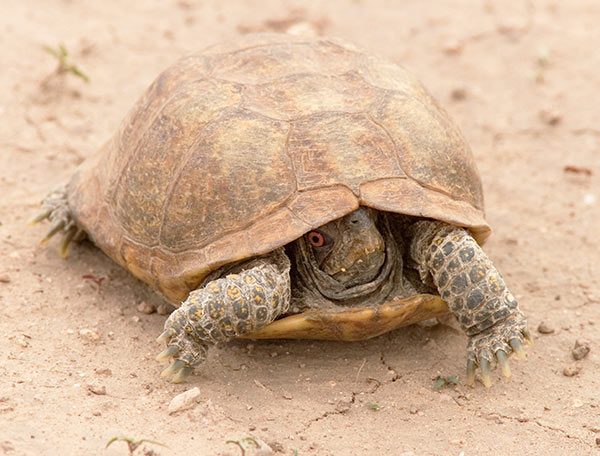
Their courtship behavior generally consists of staring in the direction of the female, following her around, and rubbing up against her. However, through the practice of sperm storage, in which a female turtle may mate with several males and hold their sperm for an extended period of time, only one or two clutches are generally laid per year. Males and females may mate with several members of the opposite sex in one mating season.

Reproduction: This species mates during the majority of its active season, between the months of April and October. Common vegetation surrounding habitat locations include various cacti (Opuntia, Echinocereus), yucca (Yucca glauca), creosote bushes (Larrea divericata), mesquite (Prosopis jusiflora), and various other small shrubs. Their home ranges generally have a great deal of leaf coverage. Uncommonly, they are also found in ponds and wetlands. Generally, these box turtles are more common in micro-habitats with high ambient temperature, and lower moisture and soil temperatures. During winter hibernation, they are found deeper, at 1.65 to 6 feet below the surface, depending on ambient temperatures. On hot summer days they are often found in small underground burrows called forms, 0.65 to 1.65 feet below the surface, averaging 1.15 feet deep. This species is also commonly found within the burrows of sand dunes. The list of foods eaten is long and includes such diverse items as dead mammals, birds and eggs, reptiles (including dead box turtles), spadefoot toad tadpoles (but not adults), crayfish, pillbugs, earthworms, carrion, spiderwort, cactus fruits and stems, melons and invertebrates found in cow dung, along with some of the dung itself.įood items are grasped by the jaws and swallowed whole or torn apart with help from the front claws, All feeding activity occurs during the daytime, using sight to locate and smell to identify food items.Habitat: The western box turtle, also called the Ornate Box turtle,6500 primarily lives in grasslands at altitudes ranging from sea level to21,200 feet, but are typically found around 5000 feet. Feeding tends to be opportunistic this may explain why an abundant food, such as insects, is an important staple in their diet. However at times certain plant foods may be eaten solely and mulberry is a favorite. These turtles are ominvorous, usually showing a preference toward animal foods. Clutch sizes range from 2-8 and two clutches may be laid each year. Nesting occurs in the late spring and summer. Activity is often increased following summer rains and thunderstorms. Shelter may be burrows in sandy soils or under fallen vegetation. This box turtle species is generally restricted to the prairies devoid of trees and dominated by grass and low shrubs.Ī diurnal species, the ornate box turtle spends its day alternating between basking, feeding, and seeking shelter from the heat of the day. No other New Mexico Turtle has a plastron with only a single hinge. The carapace length of an adult Terrapene ornata typically measures between 10-13 cm (4-5 in). Adult males with red iris females with yellow-brown iris.
WESTERN BOX TURTLE SKIN
Skin brown with spots of yellow on limbs and head. Plastron dark brown or tan plastron with pattern of radiating lines. Conspicuous pattern of radiating yellow stripes on scutes, with dark seams.

Carapace dark brown or reddish brown often with yellow middorsal stripe.

Upper jaw with downturned "beak" without notch. These land-dwelling turtles (not tortoises) have a high-domed carapace, not serrated posteriorly. Usually no obvious fading of shell with advancing age. Ornate Box Turtle Terrapene ornata ornata: Fewer pale radiating lines (5-10) on 2nd costal sheild than in Desert Box Turtle. Markings become less distinct with advancing age and eventually are lost shells of most old individuals are uniform straw color or pale greenish brown. Close to where the subspecies come together, animals may show traits of one, or both subspecies.ĭesert Box Turtle Terrapene ornata luteola: Pale radiating lines on shell more numerous than in Ornate Box Turtle, 11-14 on 2nd costal sheild. The two subspecies integrade, so the line is not a solid division. Click on a picture to see a larger version in a different window


 0 kommentar(er)
0 kommentar(er)
